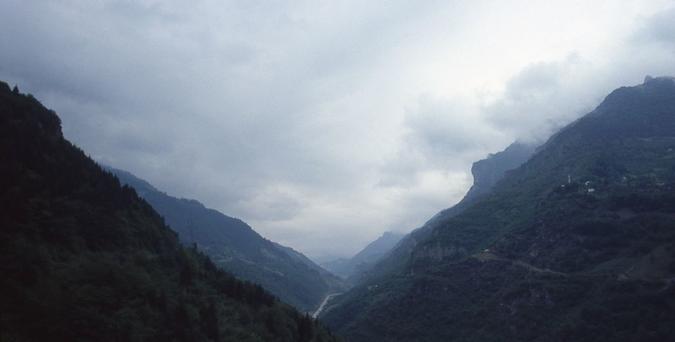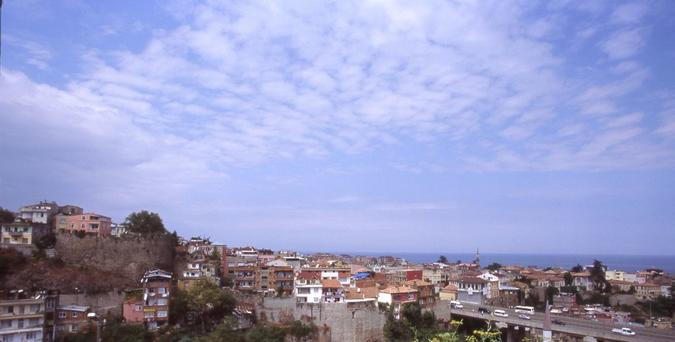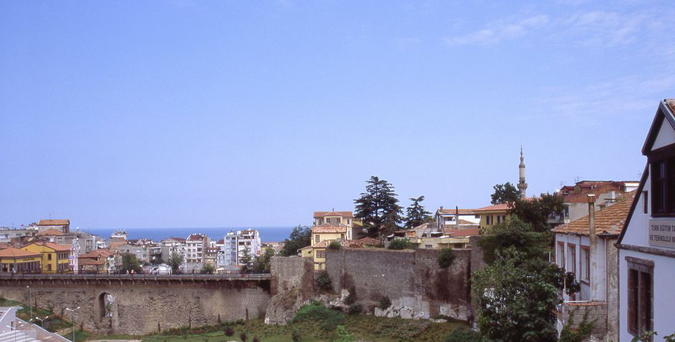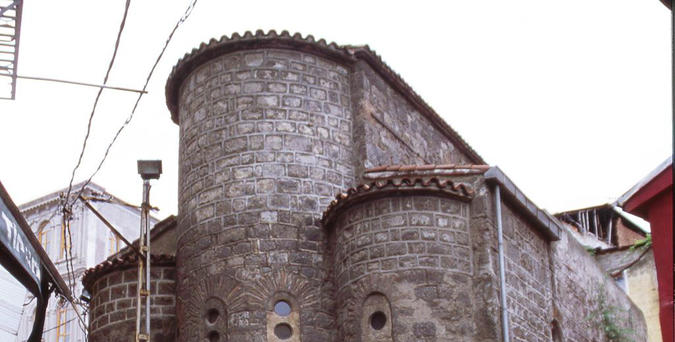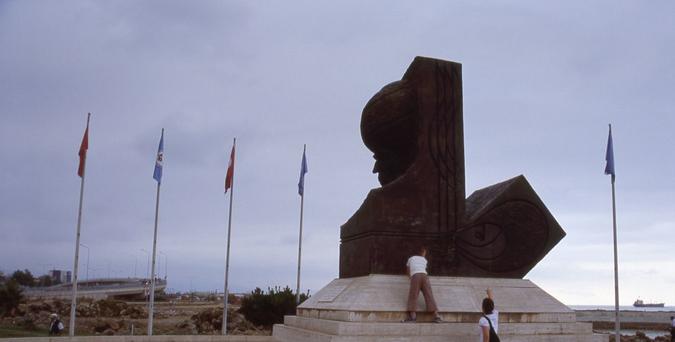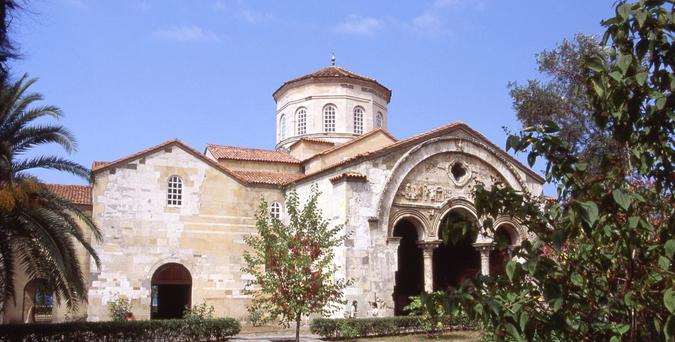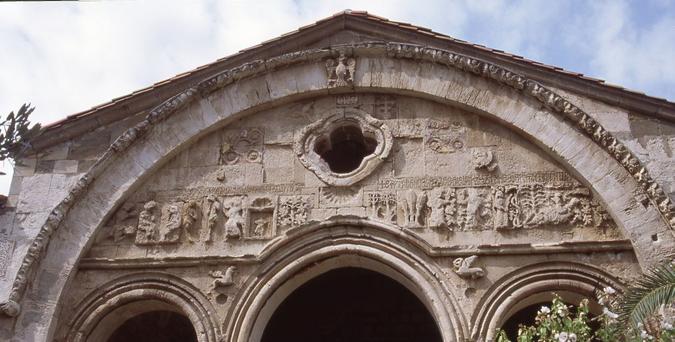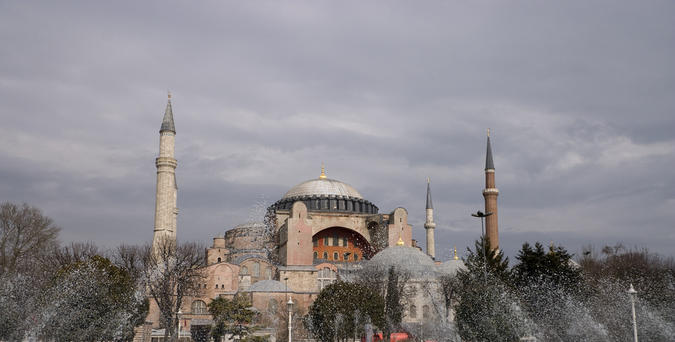The Trabzon wisdom
Trabzon is a millennial hub of trade and passage. Within its maze of streets stands the church of Aghia Sophia, whose fate is currently at stake as that of its more famous namesake in Istanbul
“To lose the trebizond” is a literary expression which dictionaries define as “to lose patience”, “to get confused” or “to lose one’s head”. The origin of the phrase is uncertain but the geographical reference is undeniable: Trebizond, today Trabzon, a Turkish port of 400,000 inhabitants on the southern coast of the Black Sea, not far from the frontiers with the Caucasian states, straight across from the Russian and Ukrainian regions bordering that Sea.
A faraway town if you like, a millennial hub of trade and passage; one of those places that inveterate travellers wished sooner or later to reach. On his way to China, Marco Polo stopped there; for centuries it was the terminus for one of the branches of the Silk Road; and, one fine day 2,400 years ago, the exhausted Greek mercenaries led by Xenophon in an adventurous return home, looking down from the high mountains behind it, finally seeing that great stretch of water, shouted the famous “thàlatta! thàlatta!” (the sea! the sea!).
One morning in August I climbed that mountain pass, the Zigana Geçidi, but from the direction of the town. Low clouds, swollen with rain, filled the air, precluding both the view of the distant sea but even of nearby houses and trees. Because – better admit it right away – Trabzon is fascinating, lively and unforgettable, but its climate leaves Mediterranean people with a bitter taste in the mouth. Even in mid-summer, winds blowing from the Sarmatic plain quickly cross the Euro-asiatic steppe unhindered, and sweep over the Black Sea. Stirring it up they capture the water vapour, lifting it to where it cools as it hits the Pontic Alps (those crossed by the Zigana Pass), to fall onto the Turkish coastal towns below – not necessarily in heavy showers but in a steady drizzle of fine drops and, above all, high humidity.
It could seem a defect, but actually it’s a blessing, this abundant supply of water at this latitude (parallel with Naples), making the hilly Black Sea coast green and fertile, with its fruitful production of hazelnuts and ubiquitous tea plantations. And when from time to time the sky clears, the whole town glitters, showing off its mighty ramparts, soaring minarets, curved hamam and tranquil Byzantine churches, while the sea in the background turns from black to blue, a light and luminous blue due to the unusually sweet water. That’s when Trabzon shows its true grandeur, an imperial grandeur, because this city was once the capital of a real empire, situated at the extreme edge of Europe. After all it would seem questionable to terminate our continent a thousand or so kilometres before that, on the Bosphorous, if we think that the last palace of Imperial Rome was built here.
The reason is easy to state: Constantinople was the “Second Rome” for a thousand years, the seat of the Roman Emperors of the Orient, but some descendants of the ruling dynasty of the Comneni had already set themselves up in Trabzon before the Latin Crusades temporarily took over the Byzantine capital in 1204. When Sultan Mehmet II conquered Constantinople definitively with the memorable siege of 1453, the Comneni survived.
Thus the last remnant of the Empire founded by Augustus and refounded in Christianity by Constantine, Trabzon, surrounded by now on all sides by the irresistible Ottoman powers, held out for another eight years, until the same Mehmet, known as Fatih (the Conqueror) took it in 1461, dethroning and then beheading the last Emperor, Davide II Comneno.
For the whole of the West, the economic and political consequences of the city passing under Turkish dominion were enormous. That port had always been fundamental to trade with the East, its lighthouse an indispensable reference point for navigating the Black Sea’s perilous rough waters. Perhaps that’s when “losing the trebizond” began to take on its figurative meaning.
Even today, anyone travelling to the Caucasus and Central Asia cannot help but stop off here, in this last great Roman-Byzantine city en route to the Orient. Some years ago, the line of ferries, which bounced from one port to another, making for a regular connection with Istanbul, was scrapped. Now the only way to get there without using a plane is by taking the extremely long coast road along the Black Sea, passing through busy fishing villages and farming communities, whose inhabitants, lacking traffic lights, risk their lives crossing it, or by-passing the larger towns with the help of a providential ring-road.
None of this in Trabzon: you suddenly find yourself under the walls which enclose the imperial heart, today as they did in the time of Mehmet’s siege. What is called Orta Hissar (middle fortress) in fact contains the slightly sloping, natural tableland on which the town was founded by Greek colonists in the remote VIII B.C.
To this position the town owes its name, formerly Trapezunte, from trapeza, Greek for table. Two stone bridges, one Roman, the other Byzantine, still connect the trapeza to external parts of the town, while other, wider, more modern viaducts attempt to deal with the traffic of lorries, buses and trumpeting collective taxis – the dolmuş – which incessantly thread their way between East and West.
Despite some local publications not wanting to name the Greeks explicitly as the former inhabitants, calling them cryptically “Milesi” (i.e. originating from Mileto, in itself a Greek colony in Ionia), or attributing its foundation to generic “Turkish tribes” in about 2000 B.C. (something highly unlikely as this would have been three thousand years before the Turks arrived in Anatolia), the lasting presence of the Pontic Greeks is manifest in the buildings of Trabzon.
Elegant, comfortable dwellings, restructured or in ruins, in faded pastel colours decorate the upper inclines of this town, with its rippling surface and uneven slopes, criss-crossed by an untidy network of alleys and streets. Here and there solitary churches resist with a half-abandoned air, like the delightful St. Anne of the IX century. Others with a solemn air are still well frequented, but only because they’ve been transformed into mosques, like the cathedral of the “Madonna with the Golden Head” (Panaghìa Krisokèfalos), now dedicated to Fatih, where the emperors of Trabzon were crowned for two and a half centuries.
Some well-restored palaces from the early twentieth century belonged to Greek entrepreneurs and were probably designed by Italian architects, like the one which at present houses the Archaeological Museum. On entering, one is welcomed by a fascinating bronze Hermes, realistic in size, who looks at you with impassive eyes, almost disbelieving his encasement in a solid glass box.
This all contributes to not making the numerous Greek tourists seem out of place when, in summer, they meet to chat loudly round the tables of the central Atatürk Meydam, while they recover with a refreshing tea after their tiring sightseeing of the town and its surroundings – the most popular visit being to the venerated sanctuary of the most saintly Madonna of Soumela, clinging to the Pontic mountains.
In fact, tens of thousands of Greeks lived here when an exchange of populations, imposed by the Treaty of Lausanne in 1923, practically emptied Trabzon (as it did the whole of the coast of the Black Sea and Anatolia), of those who had lived there for 28 centuries. It seems that, over all, those who arrived as refugees in the Greek peninsula amounted to 350,000 people.
Today’s Trabzon looks to be immersed in well-being, rich as it is in merchandise of every kind. It has also acquired, especially after the fall of the “iron curtain”, a cosmopolitan aspect, mostly characterized by a strong presence of Russians and Caucasians, who have come either on business or for leisure, engaged in purchasing or with the most disparate professional interests, as is always found in towns near easily crossed borders and with ports on the sea. The atmosphere appears much more secular than that of the inland towns on the Anatolian plateau: women are rarely seen with their face covered, at most they dress casually in multicoloured, fashionably designed scarves. Perhaps this uninhibited and apparently tolerant climate lies at the base of some of the explanations given, even in the West, for the murder of the Catholic priest Don Andrea Santoro, on February 5th, 2006 in the town: that is, that the sixteen-year-old accused of that murder, committed with a pistol, was manipulated by an extreme Nationalist, rather than Islamist fringe, and that in any case, it was “an isolated action”. However it’s as well to remember that Turkey is a complex and stratified country, made up of very varied elements, which, on the one hand imparts great fascination, on the other, opens the way to the most disconcerting events.
After all, from this town, whose supermarkets receive you with the suggestive sign “Eurasia”, came both Cardinal Bessarione, the Greek humanist, founder of the Marciana Library in Venice and one of the fathers of the Italian Renaissance, and Suliman the Magnificent, here called Kanuni the legislator, under whose rule the Ottoman Empire was at its most expansionist.
Anyone wishing to escape the lively but chaotic activity in this labyrinthine town, but not wishing to take long walks in all directions, can make their way to a peaceful oasis on the western perimeter, on the road to Giresun. Here, on a promontory overlooking the sea, stands the most evocative and best preserved church in Trabzon – Aghia Sophia.
It was built in the XIII century, when this remnant of the empire was at the height of its splendour and the Comneni defined themselves “emperors and autocrats of the entire Orient, of Iberia and Perateia”, that is, above and beyond the eastern part of the Empire, the lands of the Caucasus and those on the other shores of the Black Sea.
As with its more famous namesake in Istanbul, the St. Sofia in Trabzon was for long used as a mosque, that is until 1964 when, following important renovations, some Byzantine frescoes were brought to light, which had been covered with lime by the Ottomans, since, as is well-known, Islam does not tolerate figurative representations in its places of worship. After that the building was turned into a museum, which is its present role.
Tourists in organised groups go to see the polychromes inside, but what surprises them are the sculptures on the southern façade where biblical scenes of Genesis in relief are mixed with centaurs and gryphons more suited to pagan tradition. High up, above the portal, the single-headed eagle of the Comneni dominates – certainly less pretentious than the double-headed one of imperial Constantinople, but its glare equally proud. More prosaic is the conclusion to the visit in a tea garden alongside the reassembled remains of small marble temple, with a pause in a local jeweller’s selling bracelets and necklaces in silver thread crafted like a crocheted fabric, a speciality of local craftsmen.
The two basilicas of the same name, Aghia Sophia in Istanbul and in Trabzon, are now going through symptomatic, parallel experiences: projects which have raised some concern and a debate at the international level.
Before examining this, however, it should be remembered that Sofia is not the name of a saint here, but means rather “Divine Wisdom”. As such it is not tied to specific places and certain events, and in fact churches with this dedication were erected all over; all over, obviously, as long as the site or town had a certain importance.
The superb sacred building of ancient Constantinople was not for nothing the seat of the Orthodox Patriarch for a good 916 years, while for another 482 after the Ottoman conquest it was used as a mosque; then, like the church in Trabzon, it was transformed into a museum, open for all to visit. That happened in 1935, directly “by order of Atatürk” (as the internet site of the government dedicated to Ayasofya Muzesi records).
Now the news that has shocked the Greek Orthodox world comes in the proposal addressed to the Turkish government by a group of observant Islamists to turn the Basilica of St. Sofia in Istanbul back into a mosque set up for worship. And this while, with strange timing, a similar decision is also about to be taken by the competent authorities for the Aghia Sophia in Trabzon.
Religious matters in Turkey are not managed by an independent religious hierarchy, but dealt with by a state ministry specifically for that purpose – a legacy from the control imposed by Atatürk for this fundamental aspect of the country’s organisation. Fundamental because it was precisely on the Muslim religion that the Ottoman caliphate, overthrown in 1924, following the success of the nationalist revolution, had been based. The “Father of the Turks”, who radically reformed Turkey in the 20s and 30s of last century making it a secular country, wanted to counteract possible Islamic uprisings in this way. Paradoxically, now that there is a party of Islamic inspiration governing Turkey instead, its leaders, those in the Ministry of Culture in particular, have to decide whether to accept or reject the request from a base of the faithful (how wide this is exactly is not known) who wish to dedicate again to prayer these two buildings symbolic for Eastern Europe.
In short, in Istanbul, as in Trabzon, there is at stake not only the proposed use of the two masterpieces (one of which is comparable for its religious and historical importance with the Basilica of S. Giovanni in Laterano in Rome) but also the survival of two classic cases of that secularization begun by the founder of modern Turkey.
How will the moderate Islamic government led by Recep Tayyip Erdoğan react? On one side the predictable public opposition has been presented by the Orthodox Patriarch of Fener, moral heir to the faded Byzantine Empire and still today the most prestigious representative of Christianity in the Orient, who, with a certain understatement, notes that “ Trabzon has no urgent need for new mosques”. Not to mention Istanbul.
But on the other side, it’s clear that the request was not presented because of an effective need for new places of worship. And in fact comments on this news on the web, also taken up by English language Turkish newspapers, include those claiming the right to return to worship in holy places unjustly taken away from the faithful, clashing with those who dread the judgement of international public opinion – which in this case would accuse Turkey of falling back into narrow-minded conservatism – and so prefer to see “neutrality” preserved intact and the character of monuments belonging to the whole human race, which housed, not by chance, a transcendent and impartial “Divine Wisdom”.
Let’s hope that who has to take this fateful decision is inspired by this quality. And that no-one, as they say, “loses the trebizond”.
Featured articles
- Take part in the survey
The Trabzon wisdom
Trabzon is a millennial hub of trade and passage. Within its maze of streets stands the church of Aghia Sophia, whose fate is currently at stake as that of its more famous namesake in Istanbul
“To lose the trebizond” is a literary expression which dictionaries define as “to lose patience”, “to get confused” or “to lose one’s head”. The origin of the phrase is uncertain but the geographical reference is undeniable: Trebizond, today Trabzon, a Turkish port of 400,000 inhabitants on the southern coast of the Black Sea, not far from the frontiers with the Caucasian states, straight across from the Russian and Ukrainian regions bordering that Sea.
A faraway town if you like, a millennial hub of trade and passage; one of those places that inveterate travellers wished sooner or later to reach. On his way to China, Marco Polo stopped there; for centuries it was the terminus for one of the branches of the Silk Road; and, one fine day 2,400 years ago, the exhausted Greek mercenaries led by Xenophon in an adventurous return home, looking down from the high mountains behind it, finally seeing that great stretch of water, shouted the famous “thàlatta! thàlatta!” (the sea! the sea!).
One morning in August I climbed that mountain pass, the Zigana Geçidi, but from the direction of the town. Low clouds, swollen with rain, filled the air, precluding both the view of the distant sea but even of nearby houses and trees. Because – better admit it right away – Trabzon is fascinating, lively and unforgettable, but its climate leaves Mediterranean people with a bitter taste in the mouth. Even in mid-summer, winds blowing from the Sarmatic plain quickly cross the Euro-asiatic steppe unhindered, and sweep over the Black Sea. Stirring it up they capture the water vapour, lifting it to where it cools as it hits the Pontic Alps (those crossed by the Zigana Pass), to fall onto the Turkish coastal towns below – not necessarily in heavy showers but in a steady drizzle of fine drops and, above all, high humidity.
It could seem a defect, but actually it’s a blessing, this abundant supply of water at this latitude (parallel with Naples), making the hilly Black Sea coast green and fertile, with its fruitful production of hazelnuts and ubiquitous tea plantations. And when from time to time the sky clears, the whole town glitters, showing off its mighty ramparts, soaring minarets, curved hamam and tranquil Byzantine churches, while the sea in the background turns from black to blue, a light and luminous blue due to the unusually sweet water. That’s when Trabzon shows its true grandeur, an imperial grandeur, because this city was once the capital of a real empire, situated at the extreme edge of Europe. After all it would seem questionable to terminate our continent a thousand or so kilometres before that, on the Bosphorous, if we think that the last palace of Imperial Rome was built here.
The reason is easy to state: Constantinople was the “Second Rome” for a thousand years, the seat of the Roman Emperors of the Orient, but some descendants of the ruling dynasty of the Comneni had already set themselves up in Trabzon before the Latin Crusades temporarily took over the Byzantine capital in 1204. When Sultan Mehmet II conquered Constantinople definitively with the memorable siege of 1453, the Comneni survived.
Thus the last remnant of the Empire founded by Augustus and refounded in Christianity by Constantine, Trabzon, surrounded by now on all sides by the irresistible Ottoman powers, held out for another eight years, until the same Mehmet, known as Fatih (the Conqueror) took it in 1461, dethroning and then beheading the last Emperor, Davide II Comneno.
For the whole of the West, the economic and political consequences of the city passing under Turkish dominion were enormous. That port had always been fundamental to trade with the East, its lighthouse an indispensable reference point for navigating the Black Sea’s perilous rough waters. Perhaps that’s when “losing the trebizond” began to take on its figurative meaning.
Even today, anyone travelling to the Caucasus and Central Asia cannot help but stop off here, in this last great Roman-Byzantine city en route to the Orient. Some years ago, the line of ferries, which bounced from one port to another, making for a regular connection with Istanbul, was scrapped. Now the only way to get there without using a plane is by taking the extremely long coast road along the Black Sea, passing through busy fishing villages and farming communities, whose inhabitants, lacking traffic lights, risk their lives crossing it, or by-passing the larger towns with the help of a providential ring-road.
None of this in Trabzon: you suddenly find yourself under the walls which enclose the imperial heart, today as they did in the time of Mehmet’s siege. What is called Orta Hissar (middle fortress) in fact contains the slightly sloping, natural tableland on which the town was founded by Greek colonists in the remote VIII B.C.
To this position the town owes its name, formerly Trapezunte, from trapeza, Greek for table. Two stone bridges, one Roman, the other Byzantine, still connect the trapeza to external parts of the town, while other, wider, more modern viaducts attempt to deal with the traffic of lorries, buses and trumpeting collective taxis – the dolmuş – which incessantly thread their way between East and West.
Despite some local publications not wanting to name the Greeks explicitly as the former inhabitants, calling them cryptically “Milesi” (i.e. originating from Mileto, in itself a Greek colony in Ionia), or attributing its foundation to generic “Turkish tribes” in about 2000 B.C. (something highly unlikely as this would have been three thousand years before the Turks arrived in Anatolia), the lasting presence of the Pontic Greeks is manifest in the buildings of Trabzon.
Elegant, comfortable dwellings, restructured or in ruins, in faded pastel colours decorate the upper inclines of this town, with its rippling surface and uneven slopes, criss-crossed by an untidy network of alleys and streets. Here and there solitary churches resist with a half-abandoned air, like the delightful St. Anne of the IX century. Others with a solemn air are still well frequented, but only because they’ve been transformed into mosques, like the cathedral of the “Madonna with the Golden Head” (Panaghìa Krisokèfalos), now dedicated to Fatih, where the emperors of Trabzon were crowned for two and a half centuries.
Some well-restored palaces from the early twentieth century belonged to Greek entrepreneurs and were probably designed by Italian architects, like the one which at present houses the Archaeological Museum. On entering, one is welcomed by a fascinating bronze Hermes, realistic in size, who looks at you with impassive eyes, almost disbelieving his encasement in a solid glass box.
This all contributes to not making the numerous Greek tourists seem out of place when, in summer, they meet to chat loudly round the tables of the central Atatürk Meydam, while they recover with a refreshing tea after their tiring sightseeing of the town and its surroundings – the most popular visit being to the venerated sanctuary of the most saintly Madonna of Soumela, clinging to the Pontic mountains.
In fact, tens of thousands of Greeks lived here when an exchange of populations, imposed by the Treaty of Lausanne in 1923, practically emptied Trabzon (as it did the whole of the coast of the Black Sea and Anatolia), of those who had lived there for 28 centuries. It seems that, over all, those who arrived as refugees in the Greek peninsula amounted to 350,000 people.
Today’s Trabzon looks to be immersed in well-being, rich as it is in merchandise of every kind. It has also acquired, especially after the fall of the “iron curtain”, a cosmopolitan aspect, mostly characterized by a strong presence of Russians and Caucasians, who have come either on business or for leisure, engaged in purchasing or with the most disparate professional interests, as is always found in towns near easily crossed borders and with ports on the sea. The atmosphere appears much more secular than that of the inland towns on the Anatolian plateau: women are rarely seen with their face covered, at most they dress casually in multicoloured, fashionably designed scarves. Perhaps this uninhibited and apparently tolerant climate lies at the base of some of the explanations given, even in the West, for the murder of the Catholic priest Don Andrea Santoro, on February 5th, 2006 in the town: that is, that the sixteen-year-old accused of that murder, committed with a pistol, was manipulated by an extreme Nationalist, rather than Islamist fringe, and that in any case, it was “an isolated action”. However it’s as well to remember that Turkey is a complex and stratified country, made up of very varied elements, which, on the one hand imparts great fascination, on the other, opens the way to the most disconcerting events.
After all, from this town, whose supermarkets receive you with the suggestive sign “Eurasia”, came both Cardinal Bessarione, the Greek humanist, founder of the Marciana Library in Venice and one of the fathers of the Italian Renaissance, and Suliman the Magnificent, here called Kanuni the legislator, under whose rule the Ottoman Empire was at its most expansionist.
Anyone wishing to escape the lively but chaotic activity in this labyrinthine town, but not wishing to take long walks in all directions, can make their way to a peaceful oasis on the western perimeter, on the road to Giresun. Here, on a promontory overlooking the sea, stands the most evocative and best preserved church in Trabzon – Aghia Sophia.
It was built in the XIII century, when this remnant of the empire was at the height of its splendour and the Comneni defined themselves “emperors and autocrats of the entire Orient, of Iberia and Perateia”, that is, above and beyond the eastern part of the Empire, the lands of the Caucasus and those on the other shores of the Black Sea.
As with its more famous namesake in Istanbul, the St. Sofia in Trabzon was for long used as a mosque, that is until 1964 when, following important renovations, some Byzantine frescoes were brought to light, which had been covered with lime by the Ottomans, since, as is well-known, Islam does not tolerate figurative representations in its places of worship. After that the building was turned into a museum, which is its present role.
Tourists in organised groups go to see the polychromes inside, but what surprises them are the sculptures on the southern façade where biblical scenes of Genesis in relief are mixed with centaurs and gryphons more suited to pagan tradition. High up, above the portal, the single-headed eagle of the Comneni dominates – certainly less pretentious than the double-headed one of imperial Constantinople, but its glare equally proud. More prosaic is the conclusion to the visit in a tea garden alongside the reassembled remains of small marble temple, with a pause in a local jeweller’s selling bracelets and necklaces in silver thread crafted like a crocheted fabric, a speciality of local craftsmen.
The two basilicas of the same name, Aghia Sophia in Istanbul and in Trabzon, are now going through symptomatic, parallel experiences: projects which have raised some concern and a debate at the international level.
Before examining this, however, it should be remembered that Sofia is not the name of a saint here, but means rather “Divine Wisdom”. As such it is not tied to specific places and certain events, and in fact churches with this dedication were erected all over; all over, obviously, as long as the site or town had a certain importance.
The superb sacred building of ancient Constantinople was not for nothing the seat of the Orthodox Patriarch for a good 916 years, while for another 482 after the Ottoman conquest it was used as a mosque; then, like the church in Trabzon, it was transformed into a museum, open for all to visit. That happened in 1935, directly “by order of Atatürk” (as the internet site of the government dedicated to Ayasofya Muzesi records).
Now the news that has shocked the Greek Orthodox world comes in the proposal addressed to the Turkish government by a group of observant Islamists to turn the Basilica of St. Sofia in Istanbul back into a mosque set up for worship. And this while, with strange timing, a similar decision is also about to be taken by the competent authorities for the Aghia Sophia in Trabzon.
Religious matters in Turkey are not managed by an independent religious hierarchy, but dealt with by a state ministry specifically for that purpose – a legacy from the control imposed by Atatürk for this fundamental aspect of the country’s organisation. Fundamental because it was precisely on the Muslim religion that the Ottoman caliphate, overthrown in 1924, following the success of the nationalist revolution, had been based. The “Father of the Turks”, who radically reformed Turkey in the 20s and 30s of last century making it a secular country, wanted to counteract possible Islamic uprisings in this way. Paradoxically, now that there is a party of Islamic inspiration governing Turkey instead, its leaders, those in the Ministry of Culture in particular, have to decide whether to accept or reject the request from a base of the faithful (how wide this is exactly is not known) who wish to dedicate again to prayer these two buildings symbolic for Eastern Europe.
In short, in Istanbul, as in Trabzon, there is at stake not only the proposed use of the two masterpieces (one of which is comparable for its religious and historical importance with the Basilica of S. Giovanni in Laterano in Rome) but also the survival of two classic cases of that secularization begun by the founder of modern Turkey.
How will the moderate Islamic government led by Recep Tayyip Erdoğan react? On one side the predictable public opposition has been presented by the Orthodox Patriarch of Fener, moral heir to the faded Byzantine Empire and still today the most prestigious representative of Christianity in the Orient, who, with a certain understatement, notes that “ Trabzon has no urgent need for new mosques”. Not to mention Istanbul.
But on the other side, it’s clear that the request was not presented because of an effective need for new places of worship. And in fact comments on this news on the web, also taken up by English language Turkish newspapers, include those claiming the right to return to worship in holy places unjustly taken away from the faithful, clashing with those who dread the judgement of international public opinion – which in this case would accuse Turkey of falling back into narrow-minded conservatism – and so prefer to see “neutrality” preserved intact and the character of monuments belonging to the whole human race, which housed, not by chance, a transcendent and impartial “Divine Wisdom”.
Let’s hope that who has to take this fateful decision is inspired by this quality. And that no-one, as they say, “loses the trebizond”.

